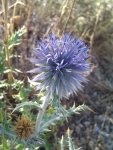Common mongrel
Echinops ritro L.
Botanical characteristics. Family Compositae. Perennial herbaceous plant with a straight light, cobweb stalk, up to 1 m high. Leaves regular, oblong, deeply drained. Blue flowers are collected in spherical inflorescences. Blooms in July-August. Fruit - a cylindrical seed - ripens in September.
Spread. Occurs in the southern part of the European territory of the country, in Western Siberia, in the Southern Urals and in Central Asia along the slopes of hills, in the steppe, on the coastal sands.
Used parts of the plant.
Fruit.
The active beginning of the pimple is the alkaloid echinopsin, its content in the seeds of the plant is 1.5-2.0%; In the stems and leaves of echinopsin is much less. Of the fruits allocated fatty oil (up to 28%).
Application.
It has a toning and restorative effect; In the experiment has a therapeutic effect for paralysis caused by mechanical damage to the nerve.
It is used for hypotension, myopathy, peripheral paralysis and paresis, plexitis, radiculitis and treatment of the consequences of poliomyelitis. Clinical trials of the drug mordovina - ehinopsin - have yielded encouraging results in the treatment of lumbosacral radiculitis, paralysis of the facial nerve and even lateral myotrophic sclerosis and multiple sclerosis. Echinopsin proved effective in the atrophy of the optic nerve and ptosis of the upper eyelid.
The Daurian dwarf is used in Chinese medicine as a hemostatic and anti-inflammatory agent.
N.G. Kovaleva recommends the fruit of a marmot as a cardiotonic.
Contraindications. The plant is toxic.
Preparation. Infusion is prepared based on 2-3 teaspoons of fruit per 1 cup of boiling water. This amount of infusion is consumed within a day.





Comments
Commenting on, remember that the content and tone of your message can hurt the feelings of real people, show respect and tolerance to your interlocutors even if you do not share their opinion, your behavior in the conditions of freedom of expression and anonymity provided by the Internet, changes Not only virtual, but also the real world. All comments are hidden from the index, spam is controlled.